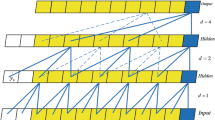Abstract
The degradation of rolling bearings is complex, and traditional methods of degenerating feature degradation are highly dependent on previous research and expertise. However, the traditional methods’ ability for learning the complex relationship between degraded features and large amounts of measured data is limited. So, it is difficult to construct a single health indicator (HI) to predict the degradation state of the bearing. In order to solve this problem, a multi-scale convolutional neural network (MSCNN) is proposed, which uses the frequency signal as input to construct HI. In combination with the “bathtub curve,” the HI we proposed is constructed by the inverse hyperbolic tangent function (atanh) method which is different from the proportional HI construction method. Five kinds of processing methods, such as original vibration signal, frequency signal and three kinds of modal decomposition preprocessed signals, are tested with PHM 2012 bearing lifetime data. And the proposed method is compared with other three HI construction methods. The experimental results show that under the HI construction method of atanh, the MSCNN model with the input of frequency signal can better represent the degradation state of the bearing compared with other methods. Meanwhile, the remaining life prediction is more accurate compared.













Similar content being viewed by others
References
Zhao Z, Liang B, Wang X et al (2017) Remaining useful life prediction of aircraft engine based on degradation pattern learning. Reliab Eng Syst Saf 164:74–83
Baptista M, Henriques EP, De Medeiros I et al (2018) Remaining useful life estimation in aeronautics: Combining data-driven and Kalman filtering. Reliab Eng Syst Saf 184:228–239
Lingli C, Beibei L, Jianfeng M et al (2018) Quantitative trend fault diagnosis of a rolling bearing based on Sparsogram and Lempel-Ziv. Measurement 128:410–418
Lei Y, Li N, Guo L et al (2018) Machinery health prognostics: a systematic review from data acquisition to RUL prediction. Mech Syst Signal Process 104:799–834
Lei Y, He Z, Zi Y (2008) A new approach to intelligent fault diagnosis of rotating machinery. Expert Syst Appl 35(4):1593–1600
Xiaoan Y, Minping J, Zhuanzhe Z (2018) A novel intelligent detection method for rolling bearing based on IVMD and instantaneous energy distribution-permutation entropy. Measurement 130:435–447
Zhao M, Tang B, Tan Q (2016) Bearing remaining useful life estimation based on time–frequency representation and supervised dimensionality reduction. Measurement 86:41–55
Gebraeel N, Lawley M, Liu R et al (2004) Residual life predictions from vibration-based degradation signals: a neural network approach. IEEE Trans Ind Electron 51(3):694–700
Benkedjouh T, Medjaher K, Zerhouni N et al (2013) Remaining useful life estimation based on nonlinear feature reduction and support vector regression. Eng Appl Artif Intell 26(7):1751–1760
Youngji Y, Jun-Geol B (2018) A novel image feature for the remaining useful lifetime prediction of bearings based on continuous wavelet transform and convolutional neural network. Appl Sci 8(7):1102–1119
Ren L, Sun Y, Wang H et al (2018) Prediction of bearing remaining useful life with deep convolution neural network. IEEE Access 6:13041–13049
Guo L, Lei Y, Li N et al (2018) Machinery health indicator construction based on convolutional neural networks considering trend burr. Neurocomputing 292:142–150
Guo L, Li N, Jia F et al (2017) A recurrent neural network based health indicator for remaining useful life prediction of bearings. Neurocomputing 240(C):98–109
She D, Jia M (2019) Wear indicator construction of rolling bearings based on multi-channel deep convolutional neural network with exponentially decaying learning rate. Measurement 135:368–375
Li X, Zhang W, Ding Q (2019) Deep learning-based remaining useful life estimation of bearings using multi-scale feature extraction. Reliab Eng Syst Saf 182:208–218
Nectoux P, Gouriveau R, Medjaher K, Ramasso E, Chebel-Morello B, Zerhouni N, Varnier C (2012) PRONOSTIA: an experimental platform for bearings accelerated degradation tests. In: Proceedings of the IEEE international conference on prognostics and health management, Denver, Colorado, USA, June 2012, pp 1–8
Jing L, Zhao M, Li P et al (2017) A convolutional neural network based feature learning and fault diagnosis method for the condition monitoring of gearbox. Meas J Int Meas Conf 111:1–10
Krizhevsky A, Sutskever I, Hinton G (2012) ImageNet classification with deep convolutional neural networks. In: International conference on neural information processing, vol 60, no 2, pp 1097–1105
Ioffe S, Szegedy C (2015) Batch normalization: accelerating deep network training by reducing internal covariate shift. In: International conference on international conference on machine learning. JMLR.org
Author information
Authors and Affiliations
Corresponding author
Additional information
Technical Editor: Zilda de Castro Silveira, Ph.D.
Publisher's Note
Springer Nature remains neutral with regard to jurisdictional claims in published maps and institutional affiliations.
Rights and permissions
About this article
Cite this article
Wu, C., Feng, F., Wu, S. et al. A method for constructing rolling bearing lifetime health indicator based on multi-scale convolutional neural networks. J Braz. Soc. Mech. Sci. Eng. 41, 526 (2019). https://doi.org/10.1007/s40430-019-2010-6
Received:
Accepted:
Published:
DOI: https://doi.org/10.1007/s40430-019-2010-6




